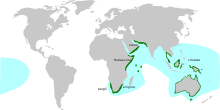| Greater crested tern | |
|---|---|

| |
| Breeding plumage T. b. bergii, Gansbaai, South Africa | |
| Scientific classification | |
| Domain: | Eukaryota |
| Kingdom: | Animalia |
| Phylum: | Chordata |
| Class: | Aves |
| Order: | Charadriiformes |
| Family: | Laridae |
| Genus: | Thalasseus |
| Species: | T. bergii
|
| Binomial name | |
| Thalasseus bergii (Lichtenstein, MHC, 1823)
| |

| |
| Approximate breeding range Wintering range | |
| Synonyms[2] | |
|
Sterna bergii Lichtenstein, 1823 | |
The greater crested tern[3] (Thalasseus bergii), also called crested tern, swift tern, or great crested tern, is a tern in the family Laridae that nests in dense colonies on coastlines and islands in the tropical and subtropical Old World. Its five subspecies breed in the area from South Africa around the Indian Ocean to the central Pacific and Australia, all populations dispersing widely from the breeding range after nesting. This large tern is closely related to the royal and lesser crested terns, but can be distinguished by its size and bill colour.
The greater crested tern has grey upperparts, white underparts, a yellow bill, and a shaggy black crest that recedes in winter. Its young have a distinctive appearance, with strongly patterned grey, brown and white plumage, and rely on their parents for food for several months after they have fledged. Like all members of the genus Thalasseus, the greater crested tern feeds by plunge diving for fish, usually in marine environments; the male offers fish to the female as part of the courtship ritual.
This is an adaptable species that has learned to follow fishing boats for jettisoned bycatch, and to use unusual nest sites such as the roofs of buildings and artificial islands in salt pans and sewage works. Its eggs and young are taken by gulls and ibises, and human activities such as fishing, shooting and egg harvesting have caused local population declines. There are no global conservation concerns for this bird, which has a stable total population of more than 500,000 individuals.
- ^ BirdLife International (2018). "Thalasseus bergii". IUCN Red List of Threatened Species. 2018: e.T22694571A132561035. doi:10.2305/IUCN.UK.2018-2.RLTS.T22694571A132561035.en. Retrieved 19 November 2021.
- ^ "Greater crested tern". Avibase.
- ^ Gill, F; Donsker, D (eds.). "IOC World Bird Names (v 2.11)". International Ornithologists' Union. Archived from the original on 2013-12-05. Retrieved 28 February 2012
